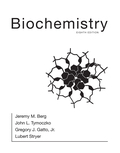
Concept explainers
Interpretation:
The equilibrium potentials of two ions at the given temperature needs to be determined.
Concept introduction:
The equilibrium potential of two ions is calculated as
Here,
Answer to Problem 5P
The equilibrium potential of calcium ions is
The equilibrium potential of chloride ions is
Explanation of Solution
Given Information:
Intracellular concentration of chloride ion,
Extracellular concentration of chloride ion,
Intracellular concentration of calcium ion,
Extracellular concentration of chloride ion,
Temperature, T = 35ºC
Calculation:
The equilibrium potential of chloride ions is calculated by
Here,
The equilibrium potential of calcium ions is calculated by
Here,
The equilibrium potential of calcium ions is
The equilibrium potential of chloride ions is
Want to see more full solutions like this?
Chapter 13 Solutions
EBK BIOCHEMISTRY
- Catabolism - draw the complete citric acid cylcle for myristatearrow_forwardEtiology? What does that mean? What does the fact that rotenone appears to increase the susceptibility to Parkinson disease indicate about the etiology of Parkinson disease?arrow_forwardQuestion:- Explain why it makes sense for the PDH complex in liver to be active when dephosphorylated.arrow_forward
- MULTIPLE CHOICE In patients with Lesch Nyhan Syndrome, purine nucleotides are overproduced and over excreted. The hypoxanthine analogue Allopurinol, which effectively treats gout , has no effect on the severe neurological symptoms of Lesch- Nyhan patients because it does not A. decrease de novo pyrimidine synthesis B. decrease de novo purine synthesis C. decrease urate synthesis D. increase PRPP levels (Phosphoribosyl pyrophosphate)arrow_forwardKetosis in Dairy Cattle: 1. Explain why propionate can contribute to the next synthesis of glucose but acetic acid cant.arrow_forward4. a. Calculate the KM (Michaelis constant) and the vmax (the maximum initial rate) for both substrates (sphingosine and ATP). Show your work, and be careful about units. b. threo-dihydrosphingosine, a stereoisomer of sphingosine, is an inhibitor of sphingosine kinase. What kind of inhibitor (competitive, uncompetitive, noncompetitive) is threo-dihydrosphingosine? Citing information from the Lineweaver-Burke plots, explain how you can tell.arrow_forward
- Disadvantages of cholesterolarrow_forwardIf intracellular [ATP] = 5 mM, [ADP] = 0.5 mM, and [Pi] = 1.0 mM, calculate the concentration of AMP at pH 7 and 25°C under the condition that the adenylate kinase reaction is at equilibrium.arrow_forwardActivity: Write the line structure of each of the following peptide at pH7 and identify how many peptide bond in each number. 1. Glycyl-valyl-serine 2. Threonyl-cysteine 3. Isoleucyl-methionyl-aspartatearrow_forward
- Activity: Write the line structure of each of the following peptide at pH7 and identify how many peptide bond in each number. 1 Alanyl-phenylalanine 2. Lysyl-alanine 3.Phenylalanyl-tyrosyl-leucinearrow_forwardQuestion- Some of the reactions of NO in the blood do not cause problems at low concentrations but can upset the normal reactions of hemoglobin if there is a large concentration of NO. The same reactions can cause trouble if a synthetic blood substitute contains a molecule similar to hemoglobin but does not contain all the other enzymes normally contained in red blood cells. Explain what this problem is and how it arises.arrow_forward
 BiochemistryBiochemistryISBN:9781305577206Author:Reginald H. Garrett, Charles M. GrishamPublisher:Cengage Learning
BiochemistryBiochemistryISBN:9781305577206Author:Reginald H. Garrett, Charles M. GrishamPublisher:Cengage Learning Biology: The Dynamic Science (MindTap Course List)BiologyISBN:9781305389892Author:Peter J. Russell, Paul E. Hertz, Beverly McMillanPublisher:Cengage Learning
Biology: The Dynamic Science (MindTap Course List)BiologyISBN:9781305389892Author:Peter J. Russell, Paul E. Hertz, Beverly McMillanPublisher:Cengage Learning


